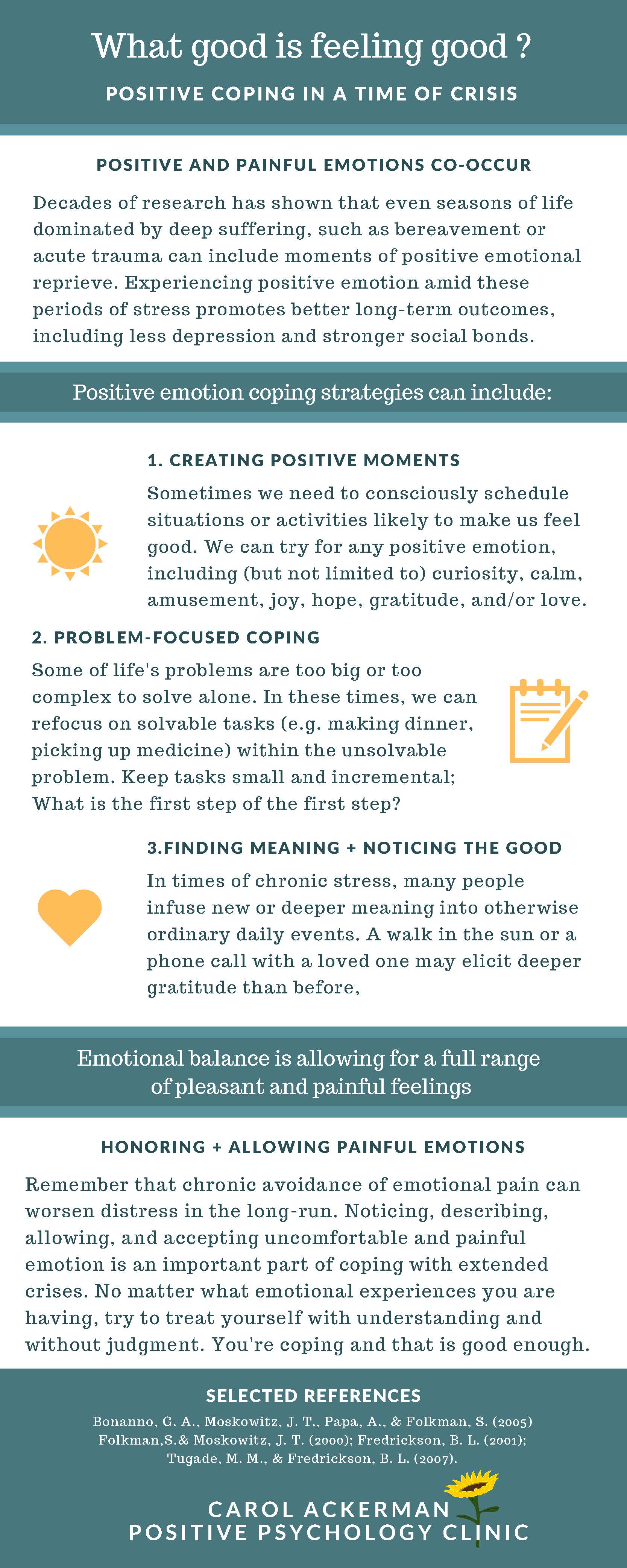The co-occurrence of positive and painful emotions
Thinking about the COVID-19 pandemic as a type of extended collective crisis allows us to look at research on other forms of crises to give us hints as to the best ways to get through this one. One important thing we have learned is that positive emotions (those with a positive valence, or feel good) and painful emotions (those with a negative valence, or feel bad) happen together.1,2 That doesn’t mean that we necessarily mean feel good and bad at the same time; typically, when positive emotions and painful emotions compete for attention, our pain is likely to win out.3 Rather, because many emotions can occur over the space of hours, days, or weeks, positive emotions can, and often do, occur even in the most painful of times.
Sometimes there are entire seasons of life that are dominated by intense painful emotions. Grief and bereavement or acute trauma recovery are times often characterized by stress and suffering.4,5 This period of life, collectively coping with the global viral pandemic of COVID-19, may be another. Already since the start of the pandemic, many people are grieving the loss of loved ones, jobs, and a loss of “normalcy”. Nearly everyone is adjusting to disrupted plans and chronic uncertainty. In times like these, it is crucial that people allow themselves to accept and feel their painful emotions, as difficult as that may be.4
And yet, even these most stressful times may include moments or whole periods of positive emotional reprieve. What’s more, when people do have times of feeling good amid periods of intense stress, they are more likely to experience better eventual psychological recovery, including less depression and stronger social bonds.1,2,7-10 Experiencing positive emotion breathes space into suffering and act as a reprieve from chronic painful feelings. Furthermore, even brief moments of positive emotion can broaden our scope of thinking, helping us respond to problems more flexibly11 and build resources – such as new knowledge or closer relationships – that we can draw on later as needed.12
Emotional balance during times of crisis is about allowing a full range of positive and painful emotions. Whatever your emotional experiences, painful or pleasant, remember to treat yourself with understanding.13 You are coping and that is good enough.
REFERENCES
1. Folkman, S., & Moskowitz, J. T. (2000). Positive affect and the other side of coping. American psychologist, 55(6), 647.
2. Tugade, M. M., & Fredrickson, B. L. (2004). Resilient individuals use positive emotions to bounce back from negative emotional experiences. Journal of personality and social psychology, 86(2), 320.
3. Baumeister, R. F., Bratslavsky, E., Finkenauer, C., & Vohs, K. D. (2001). Bad is stronger than good. Review of general psychology, 5(4), 323.
4. Bonanno, G. A. (2004). Loss, trauma, and human resilience: Have we underestimated the human capacity to thrive after extremely aversive events?. American psychologist, 59(1), 20.
5. Bonanno, G. A., Moskowitz, J. T., Papa, A., & Folkman, S. (2005). Resilience to loss in bereaved spouses, bereaved parents, and bereaved gay men. Journal of personality and social psychology, 88(5), 827.
6. Beblo, T., Fernando, S., Klocke, S., Griepenstroh, J., Aschenbrenner, S., & Driessen, M. (2012). Increased suppression of negative and positive emotions in major depression. Journal of affective disorders, 141(2-3), 474-479
7.Cohn, M. A., Fredrickson, B. L., Brown, S. L., Mikels, J. A., & Conway, A. M. (2009). Happiness unpacked: positive emotions increase life satisfaction by building resilience. Emotion, 9(3), 361.
8. Fredrickson, B. L., Tugade, M. M., Waugh, C. E., & Larkin, G. R. (2003). What good are positive emotions in crisis? A prospective study of resilience and emotions following the terrorist attacks on the United States on September 11th, 2001. Journal of personality and social psychology, 84(2), 365.
9. Moskowitz, J. T., Folkman, S., Collette, L., & Vittinghoff, E. (1996). Coping and mood during AIDS-related caregiving and bereavement. Annals of Behavioral Medicine, 18(1), 49-57.
10. Tugade, M. M., & Fredrickson, B. L. (2007). Regulation of positive emotions: Emotion regulation strategies that promote resilience. Journal of happiness studies, 8(3), 311-333.
11. Isen, A. M., Daubman, K. A., & Nowicki, G. P. (1987). Positive affect facilitates creative problem solving. Journal of personality and social psychology, 52(6), 1122.
12. Fredrickson, B. L. (2001). The role of positive emotions in positive psychology: The broaden-and-build theory of positive emotions. American psychologist, 56(3), 218.
13. Warren, R., Smeets, E., & Neff K. (2016). Self-criticism and self-compassion. Risk and resilience for psychopathology. Current Psychiatry, 15, 18-32.

What Good Is Feeling Good?
Positive Coping in a Time of Crisis
Decades of research has shown that even seasons of life dominated by deep suffering, such as bereavement or acute trauma can include moments of positive emotional reprieve. Experiencing positive emotion amid these periods of stress promotes better long-term outcomes, including less depression and stronger social bonds.
Resources
UCSB is providing up-to-date health alerts.
The University of California Office of the President is providing system wide information.
Or for more information: